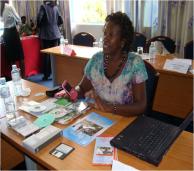One of the important considerations in extending connectivity, be it voice or data services, into small and rural communities, is the need to address scale into more remote locations. This includes the elements of local support, sustainability, as well as replication. While the technology elements have for the most part be successfully addressed, the business elements are often lacking–with the result being that once the donor funding comes to an end, all-to-often the initiatives come to an end.
In the summer of 2006, the Sri Lanka LMI project was initiated with the issuance of a Request for Proposal by USAID’s Mission in Colombo. The RFP sought proposals for establishing at a minimum of 20 telecenters in rural communities across Sri Lanka. The requirement was that these centers be fully installed and operational within one year of the contract award. The RFP also required that partners be bought into the proposal on a 2:1 match.

Photo Credit: USAID
The winning award to granted to SSG-Advisors who put forward a comprehensive approach for establishing an EasySeva franchise that would rollout the required 20 telecenters. These EasySeva centers were to be individually owned and operated by local in-community entrepreneurs. This initial rollout would subsequently be expanded beyond the USAID contract requirements.
To meet the partnership requirement, SSG-Advisors partnered with several firms, including Dialog Telekom, Sri Lanka’s largest mobile operator and who provided broadband access to the centers, and Qualcomm, who provided broadband access through their GSM-HSDPA technologies. Other partners included Microsoft, the National Development Bank (NDB), Lanka Orix Leasing Company (LOLC), and InfoShare.
The EasySeva franchise built several innovative approaches into its business model. These innovations included:
Scale—the EasySeva franchise was designed to scale well beyond the original 20 centers as reflected in the contract.
Replicable “Center in a Box”—a replicable configuration was adopted such that a new center with a full set of value-added services could be set up rapidly, with services immediately available to customers.
Locally Owned and Operated—each center is locally owned & operated by an entrepreneur vetted to ensure they are capable of managing the venture.
MicroLeasing—the NDB provided capital funding, with LOLC using these funds to buy PCs that were leased to the franchisees.
MicroLoans—LOLC also made MicroLoans available to the entrepreneurs where there was the need for start up capital and to cover initial operating costs.
Multiple Services & Revenue Streams—the EasySeva centers were constructed to derive revenue from access to content developed and placed on each PC, from local calling via community phones, from international calling via VoIP, from Internet access, copying, faxing, etc. The centers were also positioned such that they could provide local support to microLending and microLoans services into the communities.
Management & Technical Support—the EasySeva franchise operation also provides management training and technical support to the center owners.
The EasySeva franchise ultimately rolled 55 centers, well beyond the initial target. These centers are typically reaching profitability within 3-4 months after opening their doors to the local community. The model clearly proved successful in achieving scale, sustainability, and replicability. For Dialog, the telecom carrier providing the connectivity, these EasySeva centers provided community access for services not otherwise extended to those living in these more remote communities.
The EasySeva example reaches beyond Sri Lanka by providing a proof-of-concept for a scalable and replicable business, financial, and technical approach for extending connectivity and value-added services into smaller rural communities world wide.












































